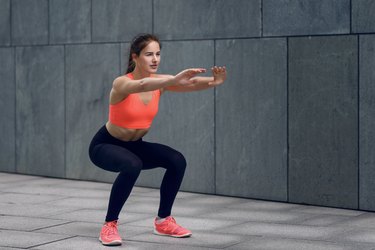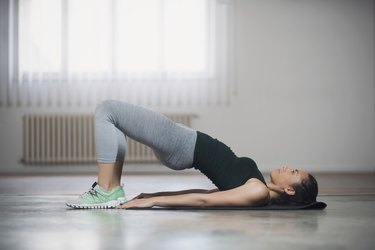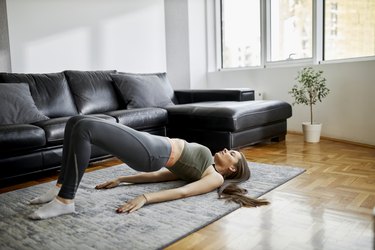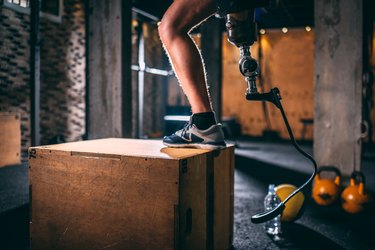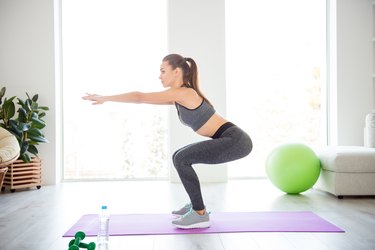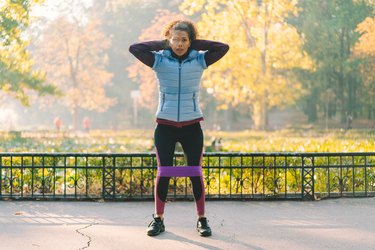
Pistol, goblet, sumo — there are enough squat variations to fill a telephone book. But one little-known type of squat, called the kang squat, deserves its own chapter.
The kang squat, which is basically a back squat paired with a good morning, touts twice the gains of a good ol' squat. Not only does it help you build a powerful lower body (read: your new go-to glute and leg exercise) but it also works your back muscles.
Video of the Day
Come to think of it, you actually get triple (or maybe even quadruple) the body benefits because the kang squat also activates your core and improves coordination.
Another bonus: Kang squats are customizable for every fitness level. They're beneficial for beginners because they don't require any equipment or extra load. In fact, your body weight will do just fine.
But if you're an advanced lifter looking for a challenge, you can always add weight (like a barbell) to make the move tougher. Either way, get ready to feel a total-body burn.
How to Do the Kang Squat
- Start standing with feet shoulder-width apart. Brace your core and interlace your hands behind your head.
- Bend your knees and hinge at the hips until your torso is approximately parallel with the ground, or as far as you can go while maintaining a flat back and active core.
- Simultaneously lower your hips and lift your chest, coming into a body-weight squat position. Keep your weight in the mid-foot and your back flat.
- Squat as deeply as your mobility will allow.
- From the bottom of the squat position, pull your hips back and up, lowering your chest forward until your torso is parallel to the floor (or as far as you can go).
- Drive your hips forward while lifting your chest as you return to standing, squeezing your glutes at the top of the move.
Tip
“Be sure to keep your abs tight,” Konnor Fleming, CPT, a personal trainer and alpha instructor at Life Time, tells LIVESTRONG.com. “Doing so will not only develop core strength and stability but also help protect the muscles of the lower back,” he says.
5 Reasons to Do the Kang Squat Every Day
Here are just a few reasons you should incorporate this dynamic exercise into your daily strength routine.
1. It Strengthens Your Glutes and Hamstrings
"By beginning with a hinge at the hip, the kang squat immediately activates the glutes and hamstrings," Fleming says.
And stronger glutes and hammies not only translate into more muscular legs, but also better performance in and out of the gym. That's because these muscle groups are "responsible for creating a great deal of power and athleticism in other movements," Fleming says.
You need sturdy, stable leg muscles for just about every move you do, like kicking a soccer ball or climbing stairs.
2. It Works Your Back Muscles
"If you thought this movement was going to just hit your legs, think again," Fleming says. "A flat back (during this hinge of the hips) is critical to both performance and safety."
And the way you establish and maintain this position is by activating your lats (in your upper back) and spinal erectors (in your lower back), he explains.
3. It Activates Your Core
"The kang squat is a movement that requires more core strength than many give it credit for," Fleming says.
Here's why: At every step of the kang squat, your core should be engaged.
Think of it like this: "How do you maintain a flat back? You activate your core. How do you support the hinged position as your shoulders descend forward and your hips pull backwards? You activate your core," Fleming says.
Put simply, your core is fully active during the entire movement.
What's more, building core strength and stability will improve your ability to perform other movements such as back squats, deadlifts and overhead presses, Fleming adds.
4. It Helps Improve Your Squat Form
The kang squat is a terrific way to fine-tune your squat technique.
That's because "the bottom position of a kang squat is the same as a body-weight squat," Fleming says. This means every repetition offers an opportunity to practice and perfect a proper squat position (with a flat back, knees in line with your toes, weight in your heels and, ideally, hips below your knees), he explains.
5. It Builds Complete Body Awareness
The kang squat involves a lot of moving parts as it requires a hinge and a squat all in one movement.
"This presents not just a physical challenge, as it activates virtually every muscle in your legs and core, but a mental challenge, too," Fleming says. "It's virtually impossible to 'mindlessly' complete a proper kang squat."
In other words, you can't just crank out kang squats by going through the motions. Instead, you need to concentrate.
"By thinking critically about the many different elements and positions of the movement, the kang squat promotes a degree of bodily awareness and control not developed by many other movement patterns," Fleming says.
And that's a major plus because focusing on good form and proper body positioning will help you get the most out of an exercise and reduce your risk of injury.
